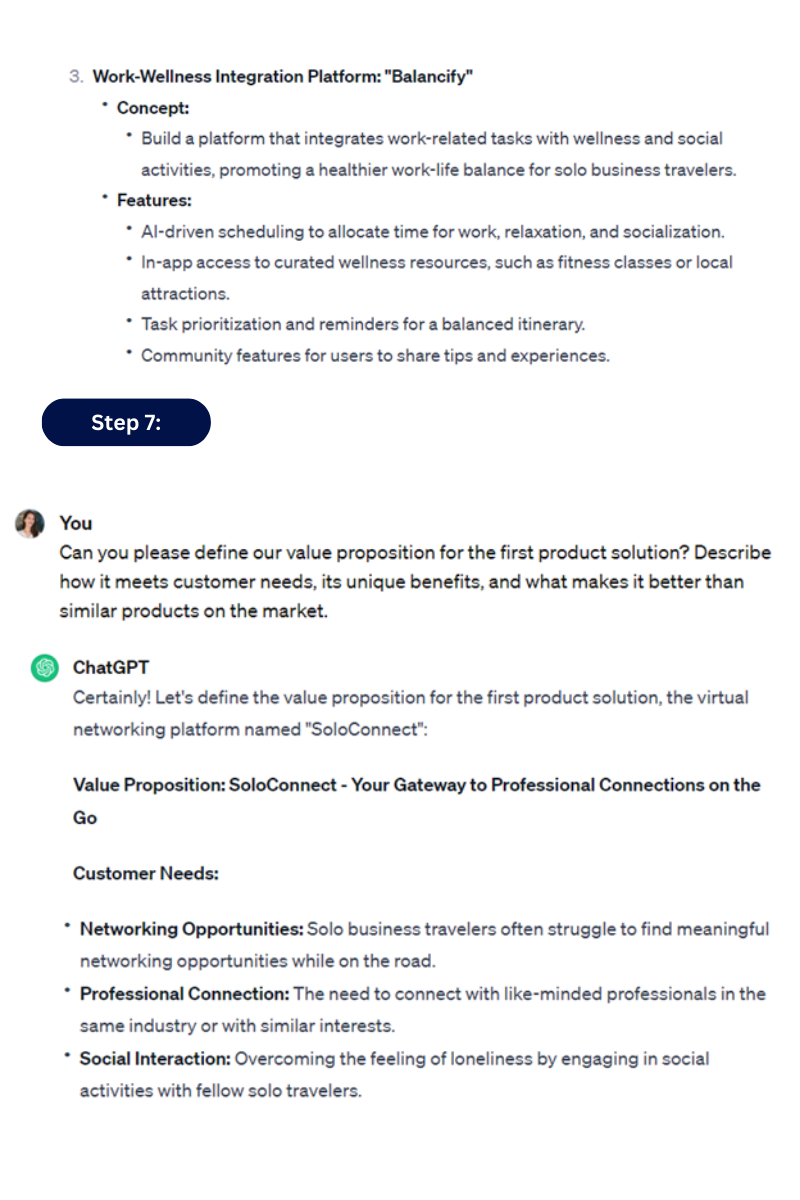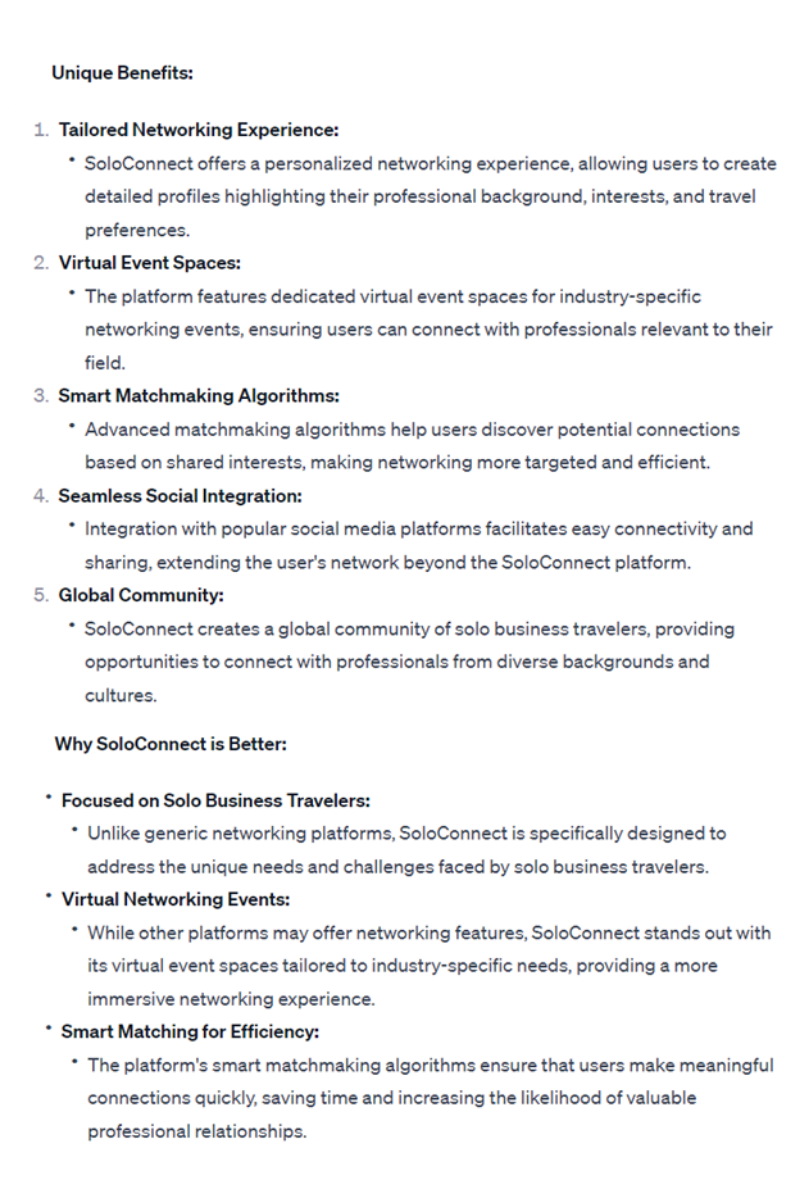When it comes to thinking about new products, we often wish for more time to conduct interviews, analyze data, and explore competitors. But these tasks take up a lot of time. That’s where ChatGPT comes in handy—it can save us time and make our processes more efficient.
Let’s dive into the world of product discovery by tapping into ChatGPT’s vast pool of data and capabilities. This guide will walk you through how to use ChatGPT for a more efficient product discovery process, helping you prepare for the development of innovative products.
- 1. Start your discovery by focusing on either your business goal or the problems you’ve noticed for a specific group of people
Prompt you can use: “I have a business objective and I’m looking to identify potential customer needs aligned with my goal. My objective is [specify your goal]. Could you please investigate the potential pain points experienced by this specific target group.”
- 2. Understanding the problem or the unsatisfied need
Prompt you can use: “Can you please act as a Product Manager and explore the actual problem underneath these pain points? Please use the ‘5 Why’s’ method to find out why this problem is happening. Once you figure out the main reason, summarize your findings in a clear problem statement.”
- 3. Defining Jobs-to-be-done (JBTD)
Prompt you can use: “Could you please identify the top 5 crucial tasks (JBTD) that my target customers need to accomplish when dealing with the problem? I aim to gain a better understanding of the key activities customers will undertake, when facing the problem.”
- 4. Defining User Personas
Prompt you can use: “Could you please outline the three user personas who are likely to be my most frequent customers?”
- 5. Preparing empathy map for our target customers
Prompt you can use: “Would you be so kind as to create an empathy map for my target customers? I’m eager to gain a deeper understanding of their thoughts, feelings, what they see and hear, and what they say and do.”
- 6. Going through an Ideation process
Prompt you can use: “Picture yourself in a room with your team, including Software Engineers, UX/UI Designers, QA Testers, a Product Owner, and a Scrum Master. During an ideation process, what would be the three standout ideas as potential product solutions for addressing this customer’s problem?”
- 7. Defining a value proposition for our product
Prompt you can use: “Can you please define our value proposition for the first product solution? Describe how it meets customer needs, its unique benefits, and what makes it better than similar products on the market.”
- 8. Doing a market research and competitive analyses
Prompt you can use: “Can you explore other companies in the market selling similar products? Summarize their strengths and weaknesses and identify areas where we can gain a competitive advantage.”
- 9. Defining functionalities
Prompt you can use: “Please outline the key features for the product solution. Consider functionality, user experience, and any unique aspects that will set our product apart in the market. “
- 10. Defining the MVP
Prompt you can use: “Can you now please define the features and functionalities that are essential for our Minimum Viable Product (MVP)? Focus on the core elements that will allow us to deliver value to our users quickly and efficiently.”
To show that these prompts truly make a difference, we put them to the test in a real-life example. In this case study below, you can follow how we turned an idea into a possible product solution, with a clear explanation of our thought process.

















At the end we’ll say that ChatGPT can be a really valuable asset in product discovery, helping us save significant time. However, it’s important to remember that while ChatGPT and AI, in general, can be incredibly helpful, they don’t guarantee the automatic success of our products. Success still relies on thoughtful execution and a comprehensive approach beyond the capabilities of AI alone.
Olgica Strezoska, Principal Product Owner at Damilah
To avoid building products that nobody wants, extensive Product Discovery is essential before embarking on the actual development process.
What is Product Discovery?
Product discovery is a dynamic and iterative process that lays the foundation for successful product development. It is the process that helps product teams understand the real problems and needs that people have and then figure out the best ways to solve them before starting development.
The concept of product discovery originated during the 1990s. During that era, companies allocated substantial portions of their marketing budgets to persuade customers of their product’s necessity. Unfortunately, this led to a lot of very expensive failures, as products often made it to full release before companies realized that people just didn’t need or want them.
The main goal of product discovery is not to ship features but rather to promote a continuous environment of learning that will help improve the product incrementally and consistently.
Product discovery is all about de-risking. As Marty Cagan puts it in his book “Inspired”, the purpose of product discovery is to address these four critical risks:
- Value risk – Will the customer buy this or choose to use it?
- Usability risk – Can the user figure out how to use it?
- Feasibility risk – Can we build it?
- Business viability risk – Does this solution work for our business?

The product Discovery process can be divided into these 4 phases:
1. Understanding Users
The first phase is all about user research and building empathy for our users. We must be able to put ourselves in users’ shoes, and that can be achieved only if we truly get to know them, listen to what they are saying, and learn about their habits, desires, and frustrations.
To achieve this understanding, several steps can be taken:
- Conduct Surveys and User Interviews: Engaging with the target audience through surveys and user interviews provides valuable insights into their preferences, pain points, and aspirations. This step helps in identifying genuine problems that need solving.
- Continuously Ask “Why” (The Five Whys method): By consistently questioning the reasoning behind the product, teams can uncover deeper insights and align their solutions more effectively with user needs.
- Observe users and create empathy maps: By synthesizing and visualizing the data from user research and interviews, empathy maps can help us identify key insights.
2. Defining the Problem
With a better understanding of the users, the next step is to precisely define the problem or need our product intends to solve. That can be done by analyzing the user research data we gathered and finding patterns that emerge from this data (using the Affinity mapping technique). By prioritizing the most important problems for users, the team can decide which user problem they want to focus on and clearly define their hypothesis before jumping into solutions.

3. Ideating and Prioritizing
Once we know what the user problem is, we should continue to the Ideation phase so that we can slowly come to the solution of the problem. This phase consists of gathering different ideas from the team (using brainstorming, mind mapping, or similar techniques) on how we can respond to the users’ problem or need. At the end of this phase, we have to prioritize the idea for which we are most confident it will bring value to the users so that we can continue prototyping and testing our hypothesis.
4. Prototyping and Validation
The final stage is about building a quick prototype to be tested and validated to gain confidence that the right product is going to be moved into the product delivery process. Prototyping ensures that the product solution aligns with the identified customer need and that users can navigate through the potential solution effectively.

Product discovery is the bedrock of successful product development. It empowers businesses to create innovative solutions that genuinely address user needs and desires. By deeply empathizing with the target audience, conducting thorough research, and actively listening to feedback, companies can build an environment of continuous learning and craft products that resonate deeply with their customers.
Olgica Strezoska, Principal Product Owner at Damilah